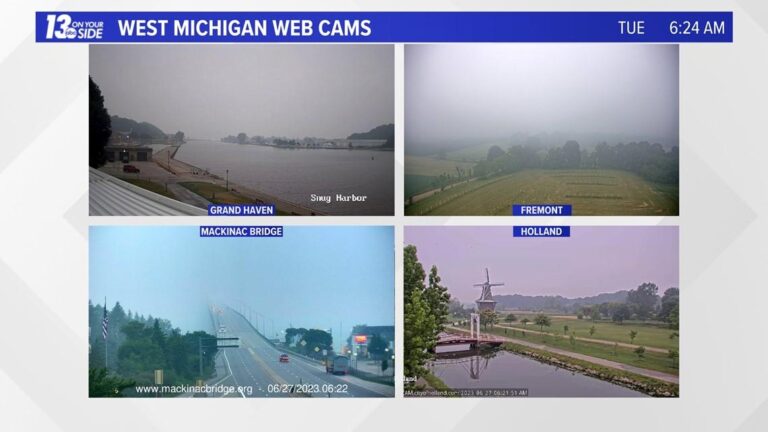Environmental experts are pushing back against recent claims by Republican officials who attribute Michigan’s deteriorating air quality to pollution originating from Canada. The controversy has sparked debate over cross-border environmental responsibility, with scientists emphasizing that local sources and long-standing industrial practices play a more significant role in the state’s pollution levels. As the discussion unfolds, public health advocates and policymakers are calling for a more nuanced understanding of the factors contributing to Michigan’s air quality challenges.
Environmental Experts Challenge Republican Claims on Michigan Air Quality
Leading environmental scientists and air quality specialists have firmly disputed recent Republican assertions attributing Michigan’s deteriorating air conditions primarily to cross-border pollution from Canada. Experts emphasize that local industrial emissions, vehicular pollution, and lax regulatory enforcement within Michigan are the principal contributors to the state’s increased levels of harmful particulate matter and ozone. According to recent air monitoring data, the state’s urban centers exhibit pollutant concentrations far exceeding those that could be explained by external sources alone.
Environmental advocates also highlight the following points to clarify the real causes behind Michigan’s air quality issues:
- Domestic industrial output: Steel mills, refineries, and manufacturing plants remain significant emitters.
- Transportation emissions: Increased traffic congestion in Detroit and surrounding areas.
- State policy gaps: Insufficient emission standards and delayed implementation of clean air initiatives.
| Source | Contribution to Pollution (%) | Notes |
|---|---|---|
| Local Industry | 55% | Largest contributor by volume |
| Vehicle Emissions | 30% | High impact in metro areas |
| Cross-border Pollution | 5% | Minimal influence compared to local sources |
| Other Sources | 10% | Includes natural and miscellaneous contributors |
Scientific Evidence Points to Domestic Sources Behind Pollution Concerns
Recent studies by environmental agencies and independent researchers emphasize that the primary contributors to Michigan’s deteriorating air quality are well within state borders. Industrial activity, vehicle emissions, and outdated power plants have been flagged as the critical factors leading to elevated pollution levels. Authorities have pointed out that while transboundary pollution is a recognized phenomenon, the lion’s share of harmful particulate matter detected around Michigan’s urban centers originates from domestic sources.
Key findings from the latest air quality reports include:
- 75% of fine particulate matter (PM2.5) linked to in-state industrial outputs.
- Major urban traffic corridors contributing to high nitrogen oxide (NOx) concentrations.
- Power plants using coal and older fossil fuels remain significant emitters despite recent regulations.
| Pollution Source | Contribution (%) |
|---|---|
| Industrial emissions | 45% |
| Traffic pollution | 30% |
| Power generation | 20% |
| Cross-border pollution | 5% |
Experts argue that diverting focus towards external blame detracts from necessary policy action. Initiatives aimed at modernizing infrastructure, enforcing stricter emissions standards, and investing in clean energy remain pivotal in addressing Michigan’s air quality challenges. Policymakers cautioned against underestimating the scope of domestic responsibility, urging bipartisan cooperation to implement sustainable solutions that can yield tangible improvements.
Recommendations for Collaborative State and Federal Action to Improve Air Quality
To effectively tackle Michigan’s air quality challenges, experts emphasize the need for synchronized efforts between state and federal agencies. Strengthening regulatory frameworks that address both local industrial emissions and transboundary pollution is pivotal. Rather than diverting blame, collaborative investment in advanced monitoring technologies and shared data platforms can provide a clearer, science-based understanding of air pollution sources and trends.
Key areas for coordinated action include:
- Joint emission reduction initiatives targeting major pollutants contributing to smog and particulate matter.
- Cross-border environmental agreements focusing on shared air basins to ensure mutual accountability.
- Increased funding for community health programs to mitigate the impacts of poor air quality in vulnerable populations.
| Collaborative Strategy | Short-Term Goal | Long-Term Impact |
|---|---|---|
| Enhanced Emissions Reporting | Improved accuracy in pollution data | Better targeted regulations |
| Regional Clean Air Task Forces | Monthly interagency coordination | Reduced cross-jurisdictional disputes |
| Community Engagement Programs | Increased public awareness | Empowered local advocacy |
To Conclude
As the debate over Michigan’s air quality continues, environmental experts emphasize the need for evidence-based solutions rather than shifting blame across borders. While political narratives may seek easy targets, scientific data points to local sources as the primary contributors to pollution. Moving forward, addressing air quality challenges will require cooperation and accountability from all stakeholders within the region, rather than politicizing environmental issues at the expense of public health.




